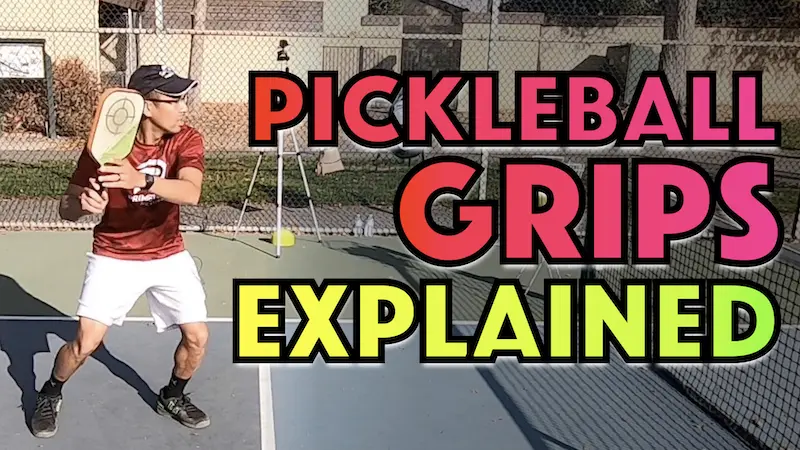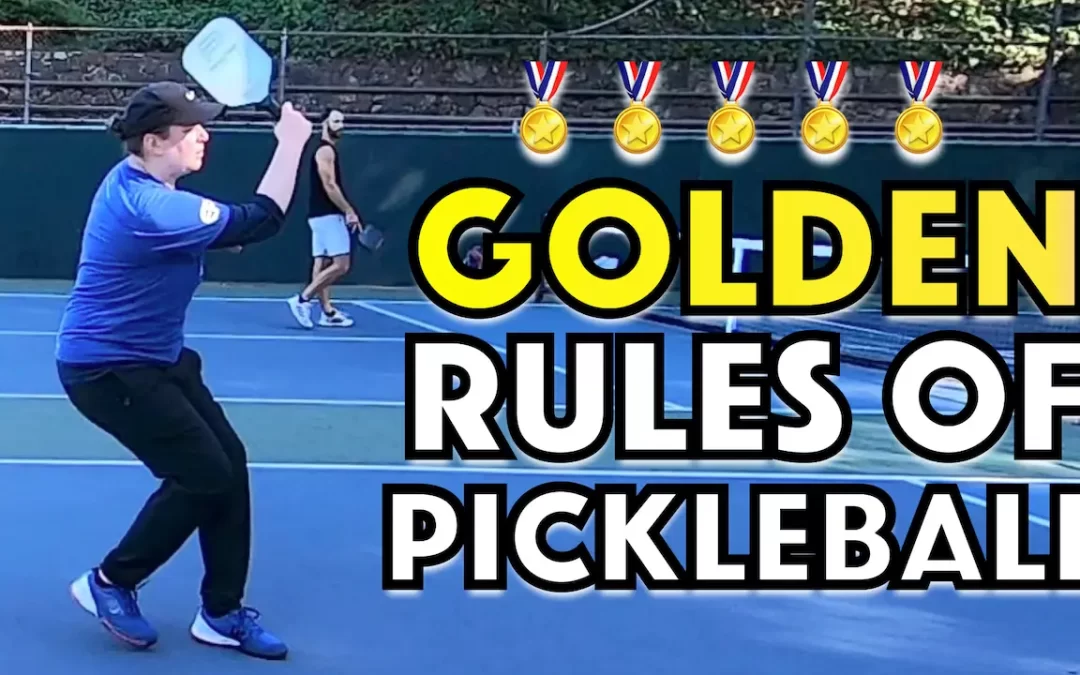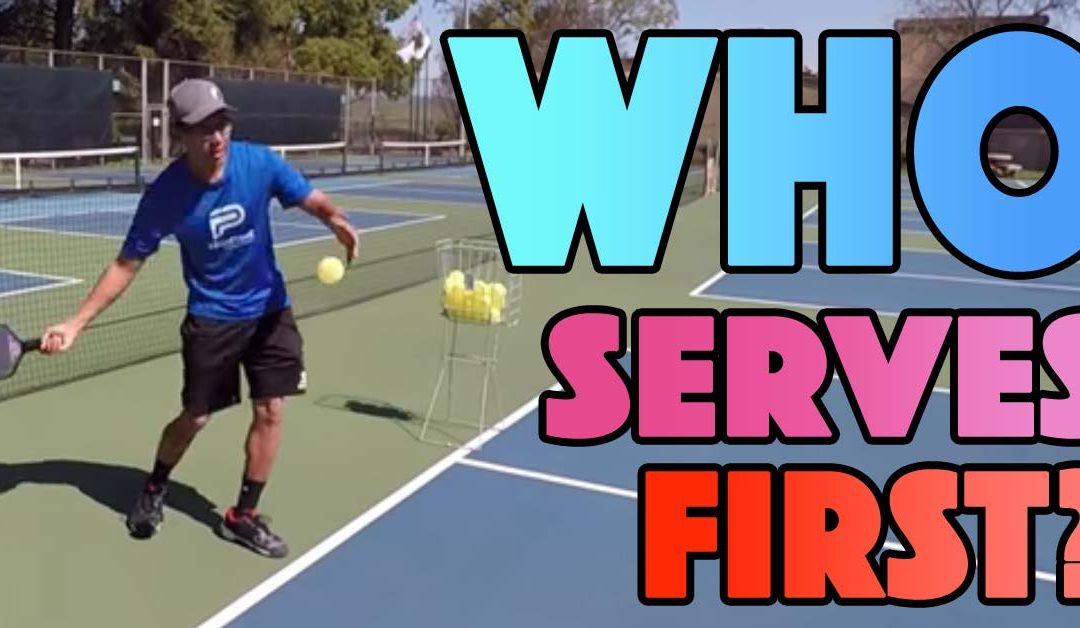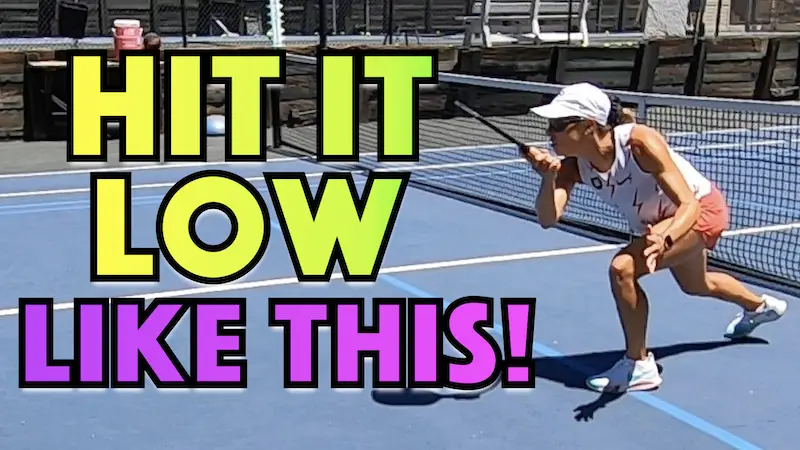The pickleball serve is one the most important aspect of the pickleball game that you need to master. It’s more than simply getting the ball across the net and into your opponent’s service court.
It can be a powerful tool that will give you options if you strike it well. One of the best ways to do that is to keep your opponent guessing.
Having various pickleball types of serves & styles in your arsenal can propel you from the beginner pickleball players category into the power players category. All the most advanced players use a volley serve (traditional serve) on all their serves because it allows for a higher contact point.
You are allowed to let the ball bounce after you release it from your hand before hitting your serve which is called a drop serve. But the ball will never get up as a high after a bounce as when you hit it from on the fly out of your hand. The higher contact point is an advantage which is why the best players all use a volley serve. In this article we’ll cover only volley serves. Click here if you are interested in learning about drop serves…
Are you ready to learn about the different types of pickleball traditional serves to master?
1. Fast & Low Serve | The Power Serve
The power serve is one of the most popular serves in pickleball. It is also a deadly serve in pickleball if done correctly.
The serve is low and hard and does best when you serve it to your opponent’s weaker side of the service area. This is usually your opponent’s backhand. The goal is to hit the ball as far back on the pickleball court as possible, near the baseline.
A serve that is powerful enough may force a weak return from your opponent. However, be prepared to follow up your strong serve with a strong drop or a driving shot if your opponents does a good job with their return. A strong serve is not a guarantee of a weak return but it can certainly improve the odds of that happening.
If you want to ensure a powerful and consistent serve then the position of your feet is an important consideration.
If you opt to use an open stance, both your feet and body should be facing the net. If you opt for a semi-open stance, your feet should be slightly more than shoulder-width apart with one foot in front of you at a 45° angle and the other behind you, slightly slanted. Any stance that ranges between the two shown below will work. Just get a stance that you’re comfortable with and ensure that your drive the back hip forward and use the rotation of your body to strike the ball. Don’t rely solely on your arm.
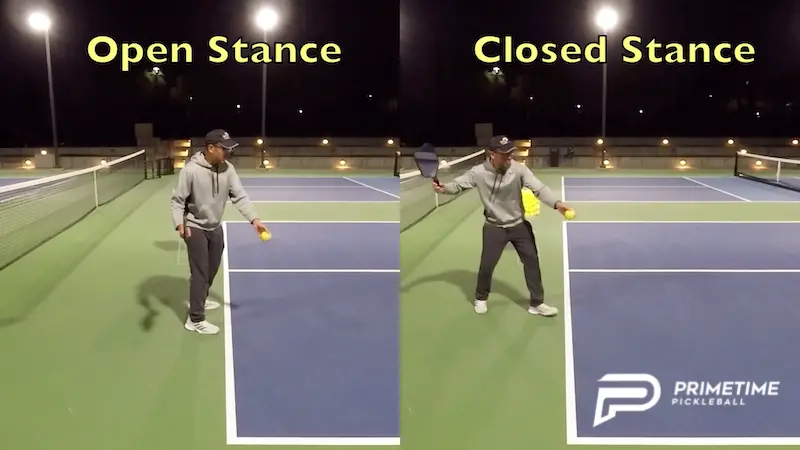
Your knees should be slightly bent and you’ll want to load up and bend more into the leg that is on the same side of your body as your hitting arm.
You want to deliver a full swing while rotating your hips and incorporating your core. The power in this shot comes from your legs, hips, and core. Keep in mind that you should deliver a full swing and not flick the ball from your wrist or elbow, mid-swing.
Your serving motion must be underhand and be a low-to-high motion to be considered a legal serve.
If you’re hitting a power serve the you will need to aim relatively low crossing the net. Your goal is to hit a powerful and fast serve with the ball landing at the baseline on the opponent’s pickleball court. You can take a little speed off and clear the net a little higher for margin of safety yet still get the ball in the back half of the service area. That is still an effective serve if you feel more comfortable hitting less than full power.
Another key point is your grip on the pickleball paddle.
Players tend to grip the paddle too tightly and it limits their power rather than help it. A looser grip allows the power that in transferring from your legs, into your core, into your arm and ultimately into your paddle. If your grip is too tight, it chokes off the power from transferring.
Who is this Serve Best For?
This serve is best for players who already have control over where they place the ball. Placement is far more important than power on all pickleball shots so it’s advisable that you are first able to get your serve deep. Once you have the control to routinely get your serve deep then you can begin to ramp up your power.
The main advantage of this serve is that it can overwhelm your opponents. When players are facing an incoming ball that is coming at a high speed, their timing has to be better. Better timing is a higher level skill so fast serves will overwhelm many players that need more time to hit the ball than you are allowing with your faster serve.
The biggest drawback is that if you haven’t perfected this serve, it can easily get away from you and sail out of bounds. The great news about serving is that you don’t need a partner to practice. You can simply grab a bucket of balls and have at it.
Power Serve Tips & Drills
- Use this serve if you know your opponent has a weak backhand. It’s also very effective against slower players. Don’t be shy to hit some to their forehand if you find they begin to crowd the area towards their backhand side. Keep them honest!
- This serve works very well in combination with the high-soft serve. Mix it up and surprise your opponent.
- The serve is easy to drill. Be sure to practice serves from both the even and odd side and. Get it deep first and then try to work on your placement to one side of the box and also the other.
2. High & Soft Serve | The Lob Serve
The lob serve, also known as the high soft serve, has a trajectory that can be described as an upside-down U shape. The ball goes high and then lands deep in the service court of your opponent.
It’s a fairly easy shot to learn.
What makes this serve unique is its slow speed and high bounce after it lands. Many pickleball players struggle to return this serve. They have so much time to think and that can be a bad thing for them since it can lead to second guessing. Sending your body mixed signals about what you want to do with the ball tends to lead to errors. Also, it seems like such an easy shot and the returner may feel compelled to hit the ball hard and overdo it with the return which also tends to lead to errors. Basically, it puts all the pressure on the returner because it’s a serve that is harder to deal with than it looks and can draw errors from your opponent. Should they miss it, they will beat themselves up because they now feel that they missed an “easy” shot. Don’t be shy about using the slow and deep lob serve. It can cause problems for your opponent.
The mechanics of the lob serve are very similar to a power serve. But there are a few key differences. The most important difference is the contact point. Your pickleball paddle will make contact with the pickleball on the underside of the ball, rather than at the back of the ball.
The second key difference is that your follow-through is aimed up toward the sky as opposed to aiming the follow-through toward your opponent.
And the last difference is that you will most likely have a slower paddle speed when hitting the lob serve. Even though you will be hitting this serve slower, don’t just arm it, still use body rotation to hit it. Don’t get lazy!
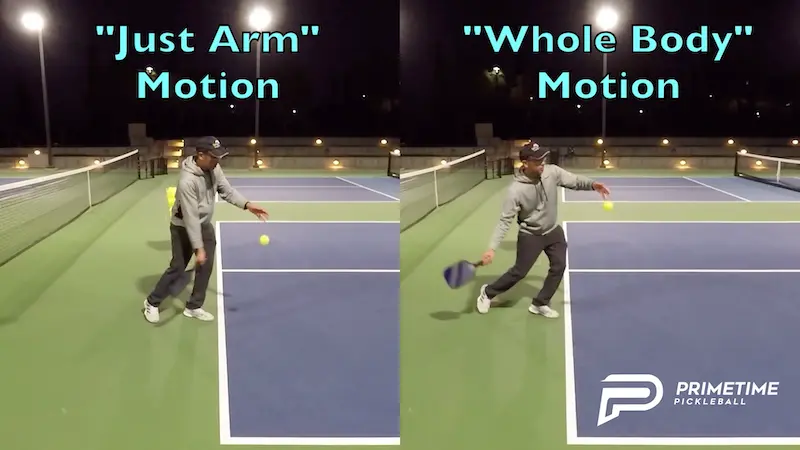
Who is this Serve Best For?
The shot is best suited to beginner players that already have a strong deep serve with some power on it. They can then use this serve to mix things up and give their opponent a different look.
The primary advantage is the low speed of the ball. It forces your opponent to have to create all their own power on the return and may result in an unbalanced return.
The disadvantage is due to the height of the arc and wind conditions. Your ball is more likely to get caught in the wind. It’s important to be cognizant of wind direction and speed. Also, you accidentally hit the serve too short than be prepared for a punishing drive.
The Lob Serve Tips & Drills
- Even the top players in the world use this serve to mix things up on their opponents. Don’t think that just because it’s slow that it’s not effective. Returns can easily mess up their return of this serve.
- Be sure you are able to consistently get this serve deep. If your landing your lob serve short then it defeats most of the benefits of the lob serve.
3. Short Angled Serve
The short angled serve is a placement serve. The ball is served and the target is just passed the NVZ line and near the sideline in the opponent’s service area.
A well-executed serve that is just passed the kitchen corner will lead your opponent off the court.
If your opponent is able to return the ball, chances are they will be quite stretched when doing so and will have to run outside the sideline in order to so leaving a rather substantial gap between them and their partner. If the return is weak then this could lead to an excellent opportunity to send a drive through the gap as it could draw an error or another weak shot.
What makes this such a unique and excellent pickleball serving choice is that your opponent may be standing at the back of their court, well behind the baseline in anticipation of a deep power serve. That’s the best moment to deliver a soft angled serve. The more unexpected it is, the more effective it will be.
It’s best if you can deliver this serve from the same location as your other serves so that you do not telegraph to your opponent that you maybe serving an angled serve. If they see you position more towards the sideline, which would make it easier to deliver the angle, it might eliminate the element of surprise. However, if you can do so in a way that is not so obvious, maybe just slide a little over that way, then it’s not a bad idea. Or, if you know that they won’t pick up on that at all then go ahead and position wherever is best for you. Many opponents are so wrapped up in what they need to do that they aren’t paying attention to what you’re doing.
Pro Tip: Pay attention to your opponents for clues about what they might be about to do even if they aren’t doing that. It gives you an edge.
Who is this Serve Best For?
This serve is ideal for players with a skill level of 3.0 and up. You need to have very good control over your placement in order to execute this serve as the target is small and there is little room for error.
This shot should be served when your goal is to move your opponent laterally and take them well out position to defend the next shot, even if they are able make the return. Many players will have a hard time recovering back into good position and you want to proceed to punish them for leaving openings in their side of the court.
There is one drawback though, which is that this is a challenging shot to master. Without sufficient practice, you could easily land the ball on the non-volley zone line, in the non-volley zone or send it wide and out of bounds.
The Kitchen Corner Serving Tips & Drills
- There are two key rules for this serve covered in the Official Pickleball Rule Book:
- The ball must clear the non-volley zone and the non-volley line.
- It may land on any other line on the court.
- You’ll want to drill this serve extensively due to the precision required. When serving to the odd court, adding a little sidespin (if your right handed) will help kick the ball even further away from your opponent. Unfortunately, that won’t work for the even side unless you’re left handed. Sidespin hit from a natural outside to inside motion on the forehand side, such as on a serve, only bends one way and not the other.
4. Sidespin Serve
You have to be careful with the sidespin serve because you could easily get caught up in hitting it in a high to low motion and that is not legal. On a traditionl serve, you must swing low to high through contact so focus on spin when hitting this serve and don’t worry about power.
Hit it deep and with significant spin that will cause it to bounce and bend to the side after the bounce. This can be a very difficult shot to time for the return and could result in a lot of weak returns for you that you can pounce on and put your opponents in even more trouble.
This is a serve that can easily throw your opponent off as they may be expecting a power or deep serve from you.
Who is this Serve Best For?
The centerline serve is best for players that range between a skill level of 3.0 and above.
Adding spin on a serve and still hitting it with accuracy is an advanced skill. It’s advisable to have the deep power serve as well as the lob serve mastered before seeking to add and master this serve. Some players just naturally hit with sidespin. Cutting the ball happens to them on almost all their shots and they have trouble hitting directly through the ball such as a deep power serve requries.
If this describes you then it’s ok to start with this and add the power deep serve in addition to this one to increase your repertoire of serves.
One of the biggest advantages of this serve is that your opponent won’t expect it plus the ball will be very jumpy after the bounce in a direction that they won’t expect.
Sidespin Serve Tips & Drills
- The swing on this serve is outside to inside and you “cut” the back of the ball from right to left to impart the spin.
- The best drill to practice this shot is through repetition. Be sure your motion is low to high. Hit the ball higher and slower rather than hard and tight to the net to help with this.
- On all serves, incorporate the same pre-service routine into your practice. This will help you to prepare physically and mentally for the shot. It helps with serve consistency. It could be something as simple as bouncing the ball twice before hitting or taking a certain position before preparing to hit the ball.
5. Advanced Serve | The Topspin Serve
The topspin is a serve that comes of your paddle spinning forward end over end because your paddle moved quickly up the back of the ball as you struck it.
This serve is most easily done out of an open or a semi-open stance. If you’re just starting to lear topspin then start by letting your paddle hang downward in an almost perpendicular position to the ground. Then swing directly up and the back of the ball with a slightly open paddle face is you make contact with the ball. Emphasis on slightly open. This will produce a low to high motion, until you finish with your paddle head towards your opposite shoulder.
Your wrist should be loose. As you move your paddle through the upward motion, it should start to pick up speed until it reaches the top.
Hitting with topspin that is created by your swing motion is and has always been allowed but at one point, players began to spin the ball with their hand or paddle (pre-spin) in addition to adding topspin with their swing motion.
There have been changes to the 2022 Official Pickleball Rulebook. One of the new rules states that you can no longer add pre-spin with your hand or the paddle.
Adding pre-spin with the paddle was nicknamed the chainsaw pickleball serve, and that serve is now illegal.
Who is this Serve Best For?
This serve is better suited to more advanced players who know how to impart topspin on the ball at varying speeds. This is not an easy skill therefore this is not an easy serve to master and will take considerable practice.
An advantage of using this serve is that it will be hard to read how much spin you have put on the ball. Any amount of topspin will cause the ball to kick more at them after it hits the ground. Aggressive topspin will kick towards them a lot and be hard to read and time.
This will make it very challenging to return the serve. This is an excellent and effective serve. If your opponent is unable to see the spin on the ball in time, they will likely get caught in a bad position and execute a weak return.
The biggest disadvantage of hitting this ball is that it is a very challenging serve to master.
The Topspin Serve Tips & Drills
- If you’re just learning topspin then start from closer up and the court and master the motion of creating friction up the back of the ball to generate the spin. Move back in the court progressively as you get better until you make it all the way back to the baseline and can hit topspin a long ways.
- Place targets deep in the service area on the other side of the court and practice hitting each target. This will help you train your accuracy.
- Check out our article on some drills to master for upping your pickleball game in addition to serves.


